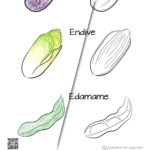Fruits and Vegetables for I
Ita Palm, imbe, and ilama are drawn in simple shapes ready for coloring. These drawings are designed to engage the curious minds of toddlers and preschoolers, spark their creativity, and hopefully healthy eating.
As always, free to download.
Did you know?
Positive Effect on Health: Beyond its captivating appearance, the Ita Palm fruit is rich in nutrients. It’s an excellent source of vitamins and minerals, including vitamin A, vitamin C, and dietary fiber. It’s particularly renowned for its high beta-carotene content, which may contribute to healthy skin and vision. Additionally, the fruit has been valued for its potential health benefits, such as supporting digestion and providing essential nutrients.
When you enjoy the Ita Palm fruit, you’re not only savoring a unique and delicious tropical treat; you’re also experiencing a taste of the rich cultural and nutritional heritage of the Amazon rainforest! 🌴🥭😋
Interesting Fact: The Ita Palm, known scientifically as Mauritia flexuosa, is a remarkable palm tree that offers a unique and versatile fruit. Native to the Amazon rainforest, this palm has played a crucial role in the diets and traditions of indigenous peoples for centuries. The fruit of the Ita Palm, often referred to as “aguaje” or “burahem,” is known for its striking reddish-pink scales and a flavor that combines a hint of carrot with a subtle sweetness.
Geographical Origin: The Ita Palm thrives in the Amazon rainforest and other tropical regions of South America, particularly in countries like Peru and Brazil. It has been a vital resource for the local populations, providing both food and materials for various purposes.
Positive Effect on Health: Imbe may not be as well-known as some other fruits, but it offers potential health benefits worth exploring. It’s a source of vitamins and minerals, particularly vitamin C, which supports immune health, and dietary fiber, which aids in digestion. Imbe is also rich in antioxidants, which may help protect your cells from oxidative stress.
When you savor the Imbe, you’re not only enjoying a unique and exotic fruit but also embracing a taste of Africa’s rich biodiversity and cultural heritage! 🍊😋🌍
Interesting Fact: The Imbe, scientifically known as Garcinia livingstonei, is a lesser-known fruit with a tantalizing taste and a connection to African landscapes. Native to the southern regions of Africa, this fruit is characterized by its small, round shape and vibrant orange to red color when ripe. Imbe’s flavor is a delightful blend of sweet and tart, making it a unique and refreshing treat.
Geographical Origin: Imbe is indigenous to parts of southern Africa, including countries like South Africa, Mozambique, and Zimbabwe. It grows in subtropical and tropical climates and has been cherished by local communities for generations.
Positive Effect on Health: Beyond its captivating taste, the Ilama offers potential health benefits. It’s a source of vitamins and minerals, including vitamin C and potassium. Additionally, it contains dietary fiber, which supports digestive health and may help maintain a feeling of fullness. The creamy, tropical delight of Ilama not only tantalizes your taste buds but also offers a taste of the exotic and potential wellness benefits from its native lands! 🍈😋🌴
Interesting Fact: The Ilama, scientifically known as Annona diversifolia, is an exotic tropical fruit that beckons with its sweet and creamy allure. Native to Central America and Mexico, the Ilama fruit is a hidden gem waiting to be discovered. It boasts a distinctive heart-shaped appearance and a flavor that marries the sweetness of banana with the creaminess of custard. The Ilama’s unique taste and texture make it a cherished delicacy in its native regions.
Geographical Origin: The Ilama fruit finds its roots in the lush landscapes of Central America and Mexico, where it has been cultivated and enjoyed for generations. It thrives in tropical climates, making it a beloved fruit in these regions.







